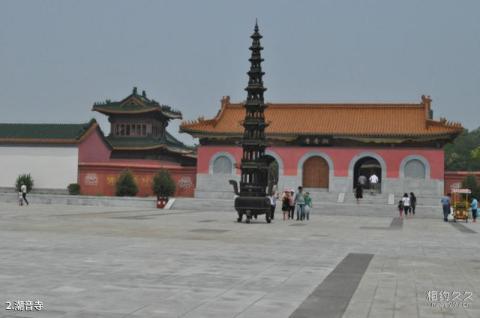
Introduction to Chaoyin Temple: Chaoyin Temple was built in the 15th year of Guangxu in the Qing Dynasty (1889). The temple monk Faben traveled to solicit donations for 14 years and was located at the former site of Chaoyang Temple in the center of the island. After 44 cold and summer years, it was finally built by The disciples of the method completed it in a vacuum and gradually developed into a famous temple in Bohai Sea.
The whole temple of Chaoyin Temple has three floors of Buddhist halls: the three rooms in the front hall are "Vajra Halls". The two chambers of the hall are divided into four painted statues of King Vajra, namely Growth, Wide Eyes, Multi-text, and Chiguo. They are majestic in shape and lifelike in expression; The "Tianwang Hall" on the second floor has three rooms in the middle. It has a unique design. The whole hall is in the shape of a pavilion, also known as the "Jiaojiao Temple". In the hall, the Heavenly King is seated, flanked by eighteen arhats in different shapes, with fine paintings and lifelike paintings. The floor of the hall is paved with bluestone. The echoes in the temple are loud and loud, and it is also known as the "Echo Temple"; the third floor is the apse with five couplets, the door is in the middle, the interior of the temple is painted, carved beams and pillars are colorful, and the walls are carved with thousands of arhats in various poses and styles, each with its own charm; On both sides of the back hall, there are eight monk's rooms on each side, six east and west auxiliary halls, sutra hall, guest house, kitchen and bathroom. The east courtyard is a place for hired workers and working monks, while the west courtyard is an area for flowers and gardens planted with trees as hedges, covering an area of more than 10 acres. The sloping path in the north of the temple leads to a quiet place. There are three jingshe (guest houses) with bright and clean windows and elegant layout, specially for guests to live in.
Chaoyin Temple reached its peak in the late Qing Dynasty and the early Republic of China. The number of monks once reached one hundred. Monks, disciples, and faithful men and women from far and near came here in an endless stream to worship, making it a Buddhist holy place. During the Anti-Japanese War and the War of Liberation, the temple was unfortunately bombarded and most of the temples were destroyed. During the "Cultural Revolution", it suffered another catastrophe. The front and middle halls were demolished, and the stone carvings of Five Hundred Arhats on the four walls of the hall were chiseled. The temple is the only remaining and restored apse at that time, and the east and west side halls that have been restored as they were.
